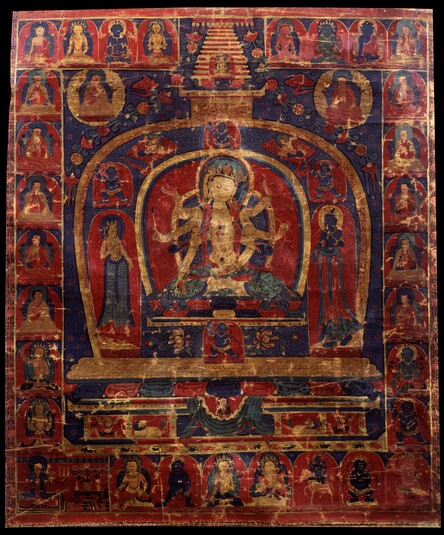
Item: Ushnishavijaya (Buddhist Deity) - (Nine Deity Configuration)
| Origin Location | Central Tibet |
|---|---|
| Date Range | 1400 - 1499 |
| Lineages | Sakya |
| Material | Ground Mineral Pigment on Cotton |
| Collection | Carolyn and Wesley Halpert |
Classification: Deity
Appearance: Peaceful
Gender: Female
Ushnishavijaya (Tibetan: tsug tor nam par gyel ma, English: The Victorious One of the Crown Protuberance) the goddess of long-life seated inside a 'victory stupa,' surrounded by eight deities.
"Ushnishavijaya, the colour of an autumn moon; with three faces, white, yellow and blue and eight hands. Each face has three very large eyes. The first right hand holds a visvavajra, second a white lotus with Amitabha residing, third an arrow and the fourth in supreme generosity. The first left holds a vajra lasso, second a bow, third bestowing protection and fourth in meditative equipoise holding an auspicious nectar vase; complete with silks and jewel ornaments, seated in [vajra] posture.
Within the outer circle of the stupa, on the right [side of the caitya], above a moon is Avalokiteshvara with a body white in colour; the left hand holds a lotus. On the left [of the caitya], above a sun is Vajrapani, blue; the left hand holds an utpala with vajra; standing in a peaceful manner and adorned with silks and jewels." (Jamyang Kyentse Wangpo, 1820-1892).
Directly below is blue Achala (Immovable) brandishing a sword in the right hand. Above and at the sides are blue Takkiraja (King of Desire) with a hook, blue Niladanda (Blue Stick) with a stick, and blue Mahabala (Great Strength) with a trident. With the left hands they perform the 'wrathful gesture' at the heart. They are adorned with jewels and snakes and wear lower garments of tiger skin. Still within the circle at the upper right and left are two Devaputras (Sons of the Gods) holding nectar vases.
Along the top are the buddhas Shakyamuni, the Five Transcendent Lords and Bhaishajyaguru (Medicine Buddha). Various lamas and lineage teachers descend at the sides. At the lower right are Green Tara, Vajrapani and Hayagriva. At the lower left is Manjushri, Avalokiteshvara and below that, the patron of the tangka seated before an offering shrine. Along the bottom from left to right are Yellow Jambhala, Black Jambhala, Yellow Vasudhara, Vaishravana, Shri Devi and Panjarnata Mahakala (followed by the already mentioned red Hayagriva).
The 'stupa,' historically a funerary mound for the remains of buddha Shakyamuni, is now seen as a geometric architectural model representing the enlightenment of all buddhas as well as a blueprint for the very path to achieve enlightenment. Each feature of the model represents an aspect of Buddhist teaching and meditation which must be accomplished in order to obtain the ultimate result. From the view of the result, the model represents all the qualities of complete buddhahood. There are three basic elements of form; a square base which acts as a throne, above that a round vase-like structure, and above that, the spire with multiple flat discs adorned with a parasol and hanging pendants. There are eight main styles of stupa construction.
Ushnishavijaya is often accompanied by the deities Amitayus and White Tara. Together they are known as the Three Long-life Deities. The practice is common to all Schools of Tibetan Buddhism.
Jeff Watt 4-2000
Buddhist Deity: Ushnishavijaya & Stupa (Painting)
Collection of Caroline & Wesley Halpert
Painting Style: Gyantse Scroll Paintings
Tradition: Sakya Deity Paintings
Buddhist Deity: Ushnishavijaya Main Page
Buddhist Deity: Deities (Female)
Buddhist Deity: Ushnishavijaya (Halpert Comparison)
Buddhist Deity: Ushnishavijaya Nine Deity
Subject: Deities & Stupas
Buddhist Deity: Ushnishavijaya (Early Paintings)
